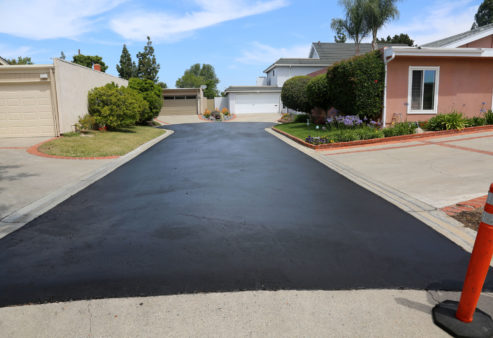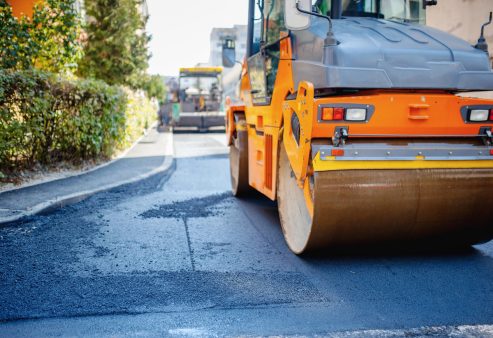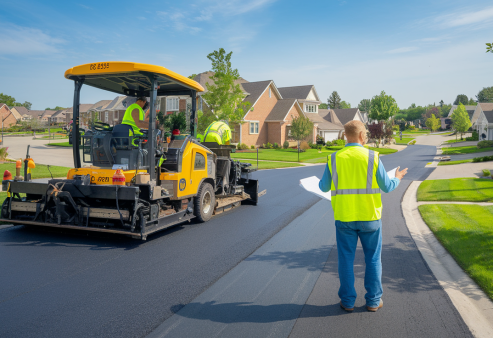5 Signs It’s Time to Repave Your Asphalt Driveway
Asphalt driveways are popular for their durability, but eventually, they all wear out. Even with good care, there comes a point when maintenance isn’t enough anymore. Here are clear signs it’s time for a full repave with expert help from TurnKey Asphalt.
From noticeable cracks that mar the surface to subtle sagging that indicates deeper issues, we’ll help you know when it’s time to repave your asphalt instead of just patching it up.
If you’re noticing any of these signs, don’t hesitate—contact TurnKey Asphalt today for a consultation and ensure your driveway remains safe and attractive.
1. Widespread Cracks
If your asphalt driveway is full of cracks, it’s time to repave. Ignoring this can lead to bigger, costlier problems down the line.
- Small Repairs: Small cracks in your asphalt driveway might not seem serious, but they shouldn’t be overlooked. While they can appear harmless, they can quickly grow into larger issues if ignored. Patching these minor imperfections may seem like a good idea, as it’s an affordable way to fix damage and prolong the life of your driveway.
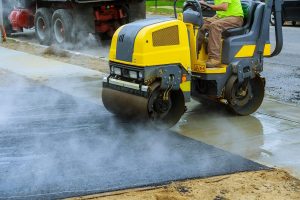 Structural Concerns: However, when cracks spread across the surface, the situation changes. Widespread cracks signal serious problems beneath the surface. This damage hints at structural concerns. Ignoring signs that your driveway’s foundation is at risk could lead to more significant problems later.
Structural Concerns: However, when cracks spread across the surface, the situation changes. Widespread cracks signal serious problems beneath the surface. This damage hints at structural concerns. Ignoring signs that your driveway’s foundation is at risk could lead to more significant problems later.- Water Damage: One major issue with cracks is water infiltration. Once water seeps through these openings, it reaches the base layers, weakening the foundation and causing further damage. During freeze-thaw cycles, this problem worsens. Water expands as it freezes, making the cracks even larger, which accelerates the deterioration process.
- Repaving Necessity: At this point, simple patching won’t suffice. The underlying issues require a stronger solution. Repaving becomes necessary to address these concerns adequately. Repaving involves removing the damaged layer and laying down a new, intact layer of asphalt. This not only improves appearance but also restores the integrity of the driveway. It’s an investment, but important for long-term durability.
2. Potholes
Potholes are a nuisance and indicate that your asphalt driveway needs attention. When they appear, it’s time to repave for a long-lasting and safe driveway.
- Formation Process: Potholes start as small cracks. Water seeps in, eroding the base layer of asphalt. Freeze-thaw cycles expand these gaps, leading to larger openings. This cycle repeats, eventually creating potholes, which signify deeper issues beneath the asphalt.
- Vehicle Damage: Potholes pose significant risks, potentially damaging tires and suspension systems. Drivers often dodge them, risking crashes, highlighting the need for prompt asphalt maintenance.
- Tripping Hazard: Pedestrians can trip and fall, creating liability concerns that stress the importance of timely repairs or replacement of the damaged pavement.
- Worsening Condition: If ignored, potholes grow larger and merge, creating bigger areas of pavement damage. This deterioration speeds up, complicating repairs and raising costs.
- Repaving Necessity: Multiple or large potholes often indicate it’s time to repave. Patching may seem economical but only provides a temporary fix. Repaving offers a long-term solution, addressing both visible and underlying issues.
3. Drainage Issues
If water collects on your asphalt driveway and doesn’t drain properly, it’s likely time to repave. Standing water can cause significant damage.
- Standing Water: Water pooling on an asphalt driveway shows drainage problems and can lead to serious damage by seeping into the asphalt. After rain, if water lingers on the surface, it’s a warning sign. The asphalt begins to weaken, leading to cracks and potholes, similar to previous issues, but here, the cause is water damage rather than just wear and tear.
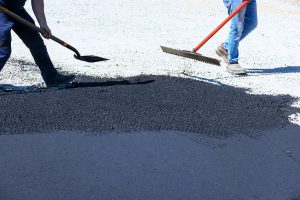 Base Erosion: Poor drainage doesn’t just affect the surface. It erodes the base of your driveway, compromising the entire structure. You’re not just dealing with surface-level issues anymore; the foundation of your driveway is at risk. The longer the water remains, the more damage it does.
Base Erosion: Poor drainage doesn’t just affect the surface. It erodes the base of your driveway, compromising the entire structure. You’re not just dealing with surface-level issues anymore; the foundation of your driveway is at risk. The longer the water remains, the more damage it does.- Repaving Solution: If you’re facing significant drainage problems, it usually means you need to repave. Repaving isn’t just about putting down new asphalt; it’s also about fixing the slope and structure of your driveway to improve drainage.
4. Fading and Discoloration
Fading and discoloration on an asphalt driveway are not just cosmetic problems. They indicate wear and tear happening beneath the surface. When you see these signs, it’s time to repave your driveway.
- UV Rays: Asphalt driveways lose their deep, dark color when exposed to the sun for extended periods. The result is a gray and faded appearance, which homeowners dislike. This fading points to deeper problems beyond aesthetics. The asphalt starts to dry out and loses its flexibility, making it fragile and more susceptible to damage.
- Weathering Impact: Weather, including rain, snow, and wind, can degrade asphalt surfaces by causing them to fade and discolor. This exposure leads to more damage over time. As this cycle of exposure continues, it accelerates the need for maintenance or complete repaving.
- Sealing vs. Repaving: Sealing can temporarily restore lost color and protect against further damage, but it’s usually just a quick fix. Widespread fading is a clear sign that sealing won’t be enough. The integrity of the driveway is at risk. At this point, repaving becomes necessary to maintain durability and restore visual appeal.
5. Age of the Driveway
The age of your driveway is a clear indicator of when it needs a repaving job. Over time, asphalt driveways show signs of wear and tear.
- Lifespan Limits: Asphalt driveways can last a long time, typically 15–20 years with regular maintenance. However, as they reach this age, their resilience diminishes. Old driveways start showing signs of wear that no quick fix can effectively address. This deterioration is not just superficial; it signals deeper structural issues.
 Signs of Aging: Cracks and uneven surfaces become more common in an aging driveway. These aren’t just cosmetic issues; they indicate that the driveway’s foundation is compromised. An old driveway may also struggle with drainage, leading to water damage and further asphalt breakdown. Regular repairs might seem like a solution, but they often only provide temporary relief for a larger problem.
Signs of Aging: Cracks and uneven surfaces become more common in an aging driveway. These aren’t just cosmetic issues; they indicate that the driveway’s foundation is compromised. An old driveway may also struggle with drainage, leading to water damage and further asphalt breakdown. Regular repairs might seem like a solution, but they often only provide temporary relief for a larger problem.- Repair or Replace?: Often the question arises: should you repair or replace a damaged driveway? If your driveway is over 20 years old, it may no longer respond well to repairs. Continuously patching problems usually ends up costing more in the long run than investing in a new driveway. Plus, a newly paved driveway can enhance the curb appeal and value of your property.
Upgrade Your Home’s Appearance With a Repaved Asphalt Driveway
If your driveway has cracks, potholes, or puddles, it’s time to repave. These issues are serious and can lead to bigger, more expensive problems. Repaving isn’t just for aesthetics; it’s essential to handle heavy use and weather damage over time.
It’s an investment that enhances your home’s appearance, safety, and value. Don’t wait for irreversible damage. Transform your driveway into a stunning entryway that welcomes you home every day.
Reach out to TurnKey Asphalt today for a free consultation and let us help you create a durable, attractive driveway that boosts your curb appeal!








 By TurnKey Asphalt
By TurnKey Asphalt  Oct 21, 2024
Oct 21, 2024  Structural Concerns: However, when cracks spread across the surface, the situation changes. Widespread cracks signal serious problems beneath the surface. This damage hints at structural concerns. Ignoring signs that your driveway’s foundation is at risk could lead to more significant problems later.
Structural Concerns: However, when cracks spread across the surface, the situation changes. Widespread cracks signal serious problems beneath the surface. This damage hints at structural concerns. Ignoring signs that your driveway’s foundation is at risk could lead to more significant problems later. Base Erosion: Poor drainage doesn’t just affect the surface. It erodes the base of your driveway, compromising the entire structure. You’re not just dealing with surface-level issues anymore; the foundation of your driveway is at risk. The longer the water remains, the more damage it does.
Base Erosion: Poor drainage doesn’t just affect the surface. It erodes the base of your driveway, compromising the entire structure. You’re not just dealing with surface-level issues anymore; the foundation of your driveway is at risk. The longer the water remains, the more damage it does. Signs of Aging: Cracks and uneven surfaces become more common in an aging driveway. These aren’t just cosmetic issues; they indicate that the driveway’s foundation is compromised. An old driveway may also struggle with drainage, leading to water damage and further asphalt breakdown. Regular repairs might seem like a solution, but they often only provide temporary relief for a larger problem.
Signs of Aging: Cracks and uneven surfaces become more common in an aging driveway. These aren’t just cosmetic issues; they indicate that the driveway’s foundation is compromised. An old driveway may also struggle with drainage, leading to water damage and further asphalt breakdown. Regular repairs might seem like a solution, but they often only provide temporary relief for a larger problem.